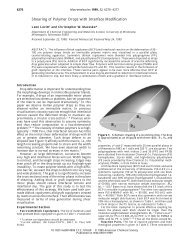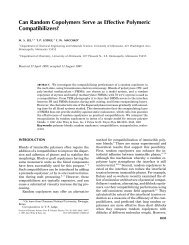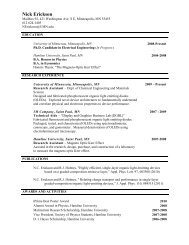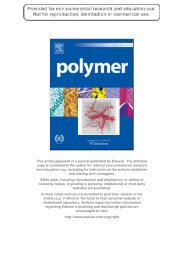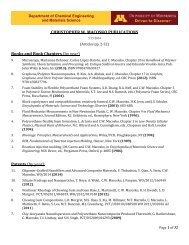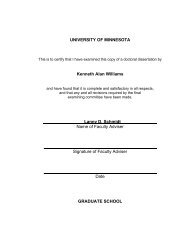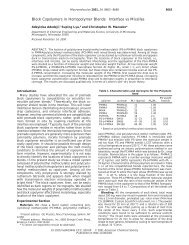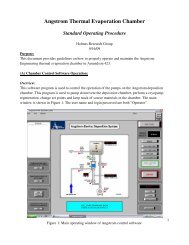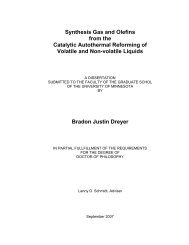Graphene Synthesis & Graphene/Polymer Nanocomposites - CEMS ...
Graphene Synthesis & Graphene/Polymer Nanocomposites - CEMS ...
Graphene Synthesis & Graphene/Polymer Nanocomposites - CEMS ...
You also want an ePaper? Increase the reach of your titles
YUMPU automatically turns print PDFs into web optimized ePapers that Google loves.
<strong>Graphene</strong> <strong>Synthesis</strong> & <strong>Graphene</strong>/<strong>Polymer</strong> <strong>Nanocomposites</strong><br />
Ken-Hsuan (Kirby) Liao<br />
Advisors: Dr. Chris Macosko<br />
Dr. Andre Mkhoyan<br />
Department of Chemical Engineering & Materials Science<br />
University of Minnesota<br />
Ph.D. Defense<br />
Minneapolis MN<br />
September 19th, 2012<br />
1
• University of Minnesota<br />
- Ph.D. Materials Science, 2008~Present<br />
<strong>Graphene</strong> <strong>Synthesis</strong> & <strong>Graphene</strong>/<strong>Polymer</strong> <strong>Nanocomposites</strong><br />
• Double Bond Chemical Co<br />
- Research & Development Engineering, 2008<br />
<strong>Polymer</strong>ic Materials<br />
• Taiwan Army, 2007~2008<br />
Biography<br />
• National Taiwan University<br />
- M.S. <strong>Polymer</strong> Science & Engineering, 2005~2007<br />
MS Thesis: Thermoplastic polyurethane composites for dental materials<br />
- B.S. Chemical Engineering, 2001~2005<br />
BS Thesis: Mechanical & thermal properties of thermoplastic polyurethane<br />
2
<strong>Graphene</strong>: monolayer of carbon<br />
atoms packed in 2D hexagonal<br />
manner<br />
<strong>Graphene</strong> Properties<br />
Modulus 1 TPa<br />
Strength 130 GPa<br />
Electrical Conductivity 6000 S/cm<br />
Surface Area 2600 m 2 /g<br />
<strong>Graphene</strong><br />
0-D: Bucky Ball,<br />
1986<br />
2-D: <strong>Graphene</strong>,<br />
2004<br />
1-D: Carbon<br />
Nanotube, 1991<br />
3-D: Graphite,<br />
1500<br />
3
Why <strong>Graphene</strong>/<strong>Polymer</strong> <strong>Nanocomposites</strong>?<br />
Light-weight stiff materials<br />
Boeing 787, contains 70,000 lb<br />
composites.<br />
From Boeing<br />
Food packaging<br />
From Brown Machine LLC<br />
BMW i8, a car made with<br />
composites.<br />
Conductive coating<br />
Picture From Mission Impossible 4<br />
From Thermal Spray Technology Inc<br />
4
Challenge of <strong>Graphene</strong>/<strong>Polymer</strong> <strong>Nanocomposites</strong>: Dispersion<br />
aspect<br />
ratio<br />
Bicerano, <strong>Polymer</strong>, 2002, 43, 369<br />
material<br />
needed<br />
>>
Motivation of Novel <strong>Graphene</strong> <strong>Synthesis</strong><br />
Criteria of <strong>Graphene</strong> <strong>Synthesis</strong> Process for <strong>Nanocomposites</strong>:<br />
1. Massive production<br />
2. Low cost<br />
3. Environmental friendly process<br />
4. Easy to transport<br />
6
<strong>Graphene</strong> Precursor: Graphite Oxide<br />
• Hydrophilic (Carbon/Oxygen=2/1)<br />
• Electrical insulator<br />
GO/water<br />
hydrophilic<br />
<strong>Graphene</strong>/water<br />
hydrophobic<br />
Gao, W. et al, Nature Nanotechnology 2011, 6, 496<br />
7
Scotch tape surfactant<br />
Novoselov et al,<br />
Science 2004, 306, 666<br />
Approaches to Produce <strong>Graphene</strong><br />
Lotya et al,<br />
JACS 2009 131, 3611<br />
Graphite Scotch Tape Nobel Prize<br />
• Advantages:<br />
Pristine graphene<br />
• Disadvantages:<br />
Low Production<br />
Oxidation<br />
H2SO4<br />
KMnO4<br />
2000 o C/s<br />
Schniepp et al,<br />
J. Phys. Chem. B 2006, 110, 8535<br />
• Advantages:<br />
High Production<br />
• Disadvantages:<br />
Slow process<br />
Low bulk density<br />
Hard to transport<br />
Safety issue<br />
4 weeks<br />
cleaning up<br />
hydrazine<br />
Li et al, Nature Nanotechnology<br />
2008, 3, 101<br />
• Advantages:<br />
High Production<br />
Higher bulk density<br />
• Disadvantages:<br />
Hazard chemicals<br />
Slow process 8
Process & Mechanism of Aqueous <strong>Graphene</strong><br />
0.34 nm<br />
0.95 nm<br />
Liao, K.-H. et al, ACS Nano, 2011, 5, 1253-1258<br />
XRD:<br />
9
Process & Mechanism of Aqueous <strong>Graphene</strong><br />
0.34 nm<br />
0.95 nm<br />
1. Liao, K.-H. et al, ACS Nano, 2011, 5, 1253-1258<br />
2. Liao, K.-H. et al, ACS Applied Materials & Interfaces, 2011, 3, 2607-2615<br />
AFM topography:<br />
10
Process & Mechanism of Aqueous <strong>Graphene</strong><br />
Liao, K.-H. et al, ACS Nano, 2011, 5, 1253-1258<br />
ARG Surface Area:<br />
~400m 2 /g by BET<br />
11
Elemental Composition of Aqueous <strong>Graphene</strong> (ARG)<br />
XPS:<br />
ARG<br />
C/O=2/1<br />
GO/water<br />
hydrophilic<br />
C/O=7/1<br />
ARG/water<br />
hydrophobic<br />
1. Liao, K.-H. et al, ACS Nano, 2011, 5, 1253-1258<br />
2. Liao, K.-H. et al, ACS Applied Materials & Interfaces, 2011, 3, 2607-2615<br />
FTIR:<br />
TEM: HR-TEM:<br />
Dispersion in water:<br />
12
Electrical Conductivity of Aqueous <strong>Graphene</strong><br />
<strong>Graphene</strong> Paper<br />
• Advantages:<br />
High production<br />
High bulk density<br />
• Disadvantages:<br />
Slow process<br />
Hazard chemicals<br />
Liao, K.-H. et al, ACS Nano, 2011, 5, 1253-1258<br />
C/O Electrical<br />
Conductivity(S/cm)<br />
GO Film 2/1 ~10 -5<br />
GS Film 7/1 ~10 1<br />
Single-layer graphene yield: 65%<br />
Single + double layer yield: > 90%<br />
Chemically Reduced <strong>Graphene</strong>: Aqueous Reduced <strong>Graphene</strong>:<br />
• Advantages:<br />
High production<br />
High bulk density<br />
Fast process<br />
No hazard chemicals involved<br />
13
Dispersion of ARG in TPU<br />
Single solvent blending process: Co-solvent blending process:<br />
Percolation concentration 1.75 wt% Percolation concentration 0.5 wt%<br />
Modulus improved by ~300% (3.0 wt%) Modulus improved by ~650% (3.0 wt%)<br />
Resistance Modulus<br />
14
<strong>Graphene</strong>/Poly-Urethane-Acrylate (PUA) Nanocomposite<br />
Idea: Disperse graphene in flowable oligomer instead of polymer for better dispersion<br />
<strong>Graphene</strong>: Vorbeck’s thermally reduced graphene (TRG)<br />
Liao, K.-H. et al, <strong>Polymer</strong>, 2012, 53, 3756<br />
ano2<br />
15
Electrical Percolation & Aspect Ratio<br />
Percolation concentration:<br />
0.15 wt%<br />
Af of dispersed TRG:<br />
~750<br />
reported Af of free standing<br />
TRG: 750<br />
Liao, K.-H. et al, <strong>Polymer</strong>, 2012, 53, 3756<br />
σ c = σ f (φ-φ perc) t<br />
Af : aspect ratio of dispersed filler<br />
σc : conductivity of nanocomposites<br />
σf : conductivity of filler<br />
r : particle radius<br />
t : particle thickness<br />
Φsphere : volume fraction of interpenetrating<br />
spheres (= 0.29)<br />
Φperc : percolation volume concentration<br />
16
Mechanical Properties of <strong>Graphene</strong>/PUA <strong>Nanocomposites</strong><br />
<strong>Polymer</strong>ized <strong>Graphene</strong>/Poly-urethane-acrylate <strong>Nanocomposites</strong>:<br />
DMA :<br />
Liao, K.-H. et al, <strong>Polymer</strong>, 2012, 53, 3756<br />
<strong>Polymer</strong>ization heat & Tg by DSC:<br />
Mori-Tanaka model simulated results<br />
(black dash lines) & real modulus (spots):<br />
TRG Load (wt%) H p (J/g) T g (°C)<br />
0 245±16<br />
0.10 244±13<br />
0.25 256±22<br />
0.50 243±15<br />
14±4<br />
17
Electrical Percolation Concentration : Literature Summary<br />
Liao, K.-H. et al, <strong>Polymer</strong>, 2012, 53, 3756<br />
18
Motivation: E graphene/E matrix literature summary<br />
0.05 wt% in<br />
PMMA<br />
Brinson et al<br />
Nature Nano 2008<br />
Theoretical<br />
Maximum<br />
Kim, Abdala, Macosko Macromolecules 2010<br />
19
Glass Transition Temperature of <strong>Graphene</strong>/PMMA <strong>Nanocomposites</strong><br />
0.05 wt% percolation concentration?<br />
Too low!<br />
30 o C of T g increase?<br />
Too high!<br />
Ramanathan et al, Nat. Nanotech. 2008 3, 327<br />
Control Groups:<br />
As Received PMMA (PMMA)<br />
As Precipitate PMMA (P-PMMA)<br />
20
Glass Transition Behavior of <strong>Graphene</strong>/PMMA <strong>Nanocomposites</strong><br />
• Glass transition temperature (Tg ) changed<br />
obviously even without incorporation of graphene!!<br />
• Coagulation process removed surfactant, which<br />
significantly decrease the Tg of PMMA.<br />
The authors did not operate coagulation process<br />
for control groups!!<br />
21
T g of <strong>Graphene</strong>/<strong>Polymer</strong> <strong>Nanocomposites</strong> – Physical Blending<br />
Solvent Blending<br />
Matrix<br />
Techn<br />
<strong>Polymer</strong> ∆Tg (°C) Filler ique Filler Load<br />
PVDF[98] 0 TRG DSC 4 wt%<br />
PBS[138] 0 CRG DMA 2 wt%<br />
LLDPE[139] 0 EG DMA 20 wt%<br />
PVDF[140] 3.5 TRG DMA 0.5 wt%<br />
TPU[122]<br />
PαMSAN/PM<br />
-2 TRG DSC 7 wt%<br />
MA[141] 0 TRG DMA 1 wt%<br />
Rubber[142] 0 GO DSC 10 wt%<br />
TPU[143] -5 EG DSC 10 vol%<br />
TPU[144] 0 TRG DMA 6 wt%<br />
PS[108] 0 CRG DMA 1.94 vol%<br />
PI[107] 2.6 γ-ABA-GO DMA 0.4 wt%<br />
PVA[132] -4.5<br />
1 wt%<br />
PMMA[132] 0.3 0.2 wt%<br />
PEI[132] 0 TRG DSC 0.1 wt%<br />
TPU[145] 0 TRG DMA 4.4 wt%<br />
Melt Blending<br />
PE[146] 0 CRG DMA 2 wt%<br />
PA12[147] 0 CRG DSC 2 wt%<br />
PET[148] < 2 TRG DMA 7 wt%<br />
PTT[149] 0 TRG DSC 7 wt%<br />
PC[111] 0 GO DMA 3 wt%<br />
PP[110] 0 GO DMA 5 wt%<br />
Solvent-Blending: Melt-Blending:<br />
GO: <strong>Graphene</strong> oxide<br />
CRG: chemically reduced graphene<br />
TRG: thermally reduced graphene<br />
EG: Expanded graphite 22
T g of <strong>Graphene</strong>/<strong>Polymer</strong> <strong>Nanocomposites</strong> – Chemical Blending<br />
In situ <strong>Polymer</strong>ize monomer in the presence of dispersed graphene<br />
23
T g of <strong>Graphene</strong>/<strong>Polymer</strong> <strong>Nanocomposites</strong> – Chemical Blending<br />
In situ <strong>Polymer</strong>ization<br />
Matrix <strong>Polymer</strong> ∆Tg (°C) Filler Technique Filler load<br />
PBI[133] 1.8 Pristine graphene DMA 0.2 wt%<br />
NIPAA[134] 0 Pristine graphene DSC 0.13 wt%<br />
Epoxy[152] 7 TRG DSC 0.05 wt%<br />
PMMA[77] 20 CRG DMA 4 wt%<br />
PMMA[128] 9 CRG DMA 1 wt%<br />
3 GO<br />
PMMA[129]<br />
8 CRG<br />
DMA 1 wt%<br />
14<br />
DSC<br />
19 GO<br />
DMA<br />
PMMA[76]<br />
7 AIBN-GO DSC & DMA<br />
6 wt%<br />
Vinyl Ester[155] 7 TRG -- 0.2 phr<br />
4 GO<br />
0.5 wt%<br />
PUA[156]<br />
3.4 Isocyanate-GO DSC<br />
1 wt%<br />
PUA[157] 0 TRG DSC & DMA 0.5 wt%<br />
PUA[158] 7 CRG DMA 1 wt%<br />
PS[159] 8 PS-modified CRG DSC 2.5 wt%<br />
Commonly T g change was reported for chemical blending process<br />
24
T g of <strong>Graphene</strong>/<strong>Polymer</strong> <strong>Nanocomposites</strong> – Aqueous Blending<br />
Aqueous Blending (solvent blending with water as solvent)<br />
Matrix <strong>Polymer</strong> ∆T g (°C) Filler Technique Filler load<br />
PVA[104] 12 CRG DSC 7.5 wt%<br />
PVA[170] 4 CRG DSC 0.5 wt%<br />
PVA[105] 14 CRG DSC 3.5 wt%<br />
PVA[171] 9 GO DSC 0.72 vol%<br />
PVA[172] 4 GO DSC 0.7 wt%<br />
Chitosan[135] 5 GO DSC 1 wt%<br />
Gelatin[173] 10 GO DSC 2 wt%<br />
PEO[174] 9 TRG DMA 4 wt%<br />
Commonly T g change was<br />
reported for aqueous blending<br />
process<br />
25
T g of <strong>Nanocomposites</strong> & <strong>Polymer</strong> Nano-confinement<br />
Nanoconfinement & nanocomposites<br />
Tacticity effect of nanoconfinement<br />
Mayes A, Nature Materials 2005, 4, 651<br />
Grohens Y et al. Langmuir 1998, 14, 2929<br />
26
Dispersion of TRG/PMMA <strong>Nanocomposites</strong><br />
Samples: TRG/syndiotactic-rich-PMMA (a-PMMA)<br />
TRG/isotactic-PMMA (i-PMMA)<br />
in situ TRG/PMMA<br />
Resistance: (by 11-Probe) Modulus:<br />
Dispersion levels of TRG are similar<br />
Af ~200<br />
27
Tacticity Effect on T g of TRG/PMMA <strong>Nanocomposites</strong><br />
Samples: TRG/a-PMMA<br />
TRG/i-PMMA<br />
tanδ [tan(E”/E’)] by DMA of:<br />
TRG/a-PMMA i-PMMA<br />
28
Tacticity Effect on T g of TRG/PMMA <strong>Nanocomposites</strong><br />
Interaction Density:<br />
i-PMMA > a-PMMA<br />
Interaction Intensity:<br />
i-PMMA > a-PMMA<br />
n(T): number of H-bonds per P2VP block<br />
Noro, Matsushita, Lodge Macromolecules<br />
2008, 41, 5839-5844<br />
29
Process Effect on T g of TRG/PMMA <strong>Nanocomposites</strong><br />
Samples: in situ TRG/PMMA<br />
TRG/a-PMMA<br />
tanδ [tan(E”/E’)] by DMA of:<br />
TRG/atactic-PMMA in situ TRG/PMMA<br />
30
Possible Reactions during in situ <strong>Polymer</strong>ization<br />
~1 % of PMMA covalently grafted on TRG<br />
31
Process of separating filler and matrix polymer for in situ system<br />
In situ TRG/PMMA<br />
nanocomposites film<br />
dissolve<br />
in THF filtration<br />
rinse<br />
T g by DSC:<br />
dry<br />
32
Process of separating filler and matrix polymer for in situ system<br />
33
inding holes perfectly covered by single-layer GO:<br />
TEM:<br />
AFM:<br />
Lee, C. et al Science 2008, 321, 385<br />
Oxygen Effect on <strong>Graphene</strong> Oxide<br />
TEM grid<br />
Hole size: 2.5µm in diameter<br />
Force = (TM Deflection) × (Cantilever Spring Constant)<br />
34
Lee, C. et al Science 2008, 321, 385<br />
Atomic structure of single-layer GO:<br />
Mkhoyan, K. A. et al, Nano Letters, 2011, 9, 1058<br />
Oxygen Effect on <strong>Graphene</strong> Oxide<br />
Bridge (C-O-C) bonds<br />
were removed after<br />
chemical reduction<br />
TEM grid<br />
Hole size: 2.5µm in diameter<br />
Force = (TM Deflection) × (Cantilever Spring Constant)<br />
35
Fast, scalable,<br />
green process with<br />
massive production<br />
Conclusion<br />
In situ <strong>Polymer</strong>ization<br />
Melt Blending<br />
Solvent Blending<br />
• Mechanical Properties: Elastic modulus increase 100% with 0.5 wt% of graphene<br />
• Thermal Properties: Glass transition temperatures affected by process and tacticity<br />
• Electrical Properties: Surface resistance decrease 10 10 times with 1 wt% of graphene<br />
• Techniques used: AFM, Rheometer, DMA, XRD, SAXS, TEM, SEM, XPS, FTIR,<br />
GPC, TGA, DSC, universal tensile testing instrument.<br />
36
Acknowledgement<br />
• Dr. Chris Macosko (<strong>CEMS</strong>)<br />
• Dr. Andre Mkhoyan (<strong>CEMS</strong>)<br />
• Dr. Greg Haugstad<br />
• Steven Maslo, Jerry Yeh<br />
• Group Members<br />
37



